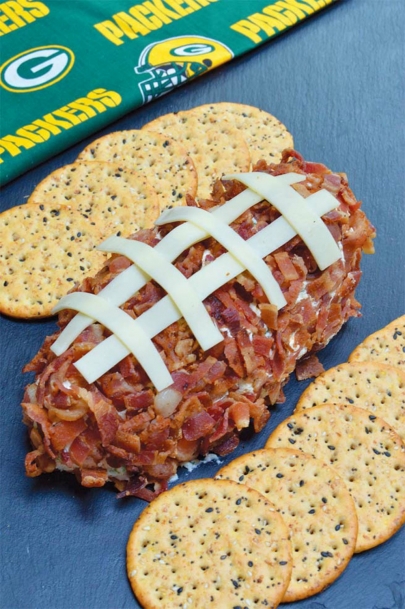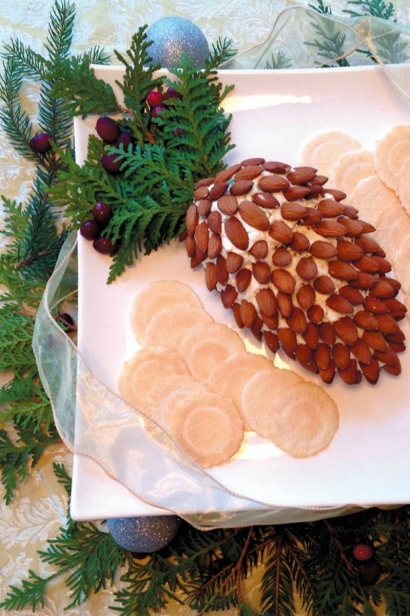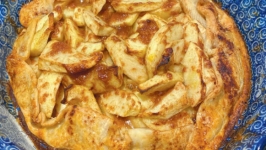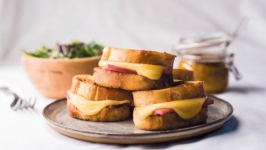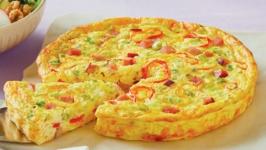Cheese Balls Can be Far From Ordinary
Knock. Knock. Who’s there? It’s your neighbor with a gift of a cheeseball. And it weighs 1,235 pounds.
Legend has it the first cheese ball was presented as a gift to then President Thomas Jefferson by a local farmer named Elisha Brown, Jr. and, yes, it weighed 1,235 pounds.
Thankfully, today’s cheese balls are much more consumer-friendly.
A Little Bit of Kitsch. A Whole Lot of Fun.
When cheeseballs are mentioned, images of orange shag carpet, lava lamps and three-layered Jello molds may dance in your head. Cheese balls are known for a certain element of kitsch they bring to an appetizer spread. Traditionally made with a mixture of colorful Cheddar cheese and studded with chopped nuts, the image of a cheese ball on the appetizer table may draw a chuckle and a smile, but at the end of the night, there’s usually “no cheese left behind.”
Locally-Made
One of our country’s largest producers of cheese balls and cheese logs is located in our own backyard.
Kaukauna Spreadable Cheese, a division of Bel Brands, is headquartered in Chilton. What began as a small dairy distribution center in 1918 by founder Hubert Fassbender has grown into the nation’s largest manufacturer of cheese balls and cheese logs.
“Last holiday season, Kaukauna sold almost 6 million cheese balls and cheese logs,” said Kelly Aschliman, Brand Manager of Refrigerated Spreads at Bel Brands, USA. “Our two top flavors are port wine and sharp Cheddar, but this year we’ve added a new seasonal item with our Kaukauna sriracha-flavored cheese ball covered in red bell pepper flakes.”
Though premade cheese ball products are a great addition to any party, why not try your hand at creating your own unique offering?
Are You Ready For Some Cheese Ball?
Today’s cheese balls have entered the artisan phase. The great thing about working with a moldable product like cheese is that it can take any shape the culinary artist wants it to be.
Football season means it’s time for another kind of pigskin. Yes, it’s time to make the ultimate pigskin cheese ball. A simple combination of cream cheese and shredded white Cheddar or Swiss cheese is combined with green onions, herbs and spices. A little sculpting and you have the base of your cheeseball football.
And the final touch? Bacon, of course. Crumbled cooked bacon gives the edible football the look of pigskin and the taste so many football fans live for. Strips of mozzarella or provolone cheese form the football laces.
… the image of a cheese ball on
the appetizer table may draw a
chuckle and a smile, but at the end
of the night, there’s usually
“no cheese left behind.”
The Centerpiece Cheese Ball
For a more elegant cheese ball presentation, create an edible pinecone with cream cheese, dried herbs and spices and whole skin-on almonds.
Plastic wrap is your best friend when molding cheese into creative shapes. Place the cream cheese mixture on a large sheet of plastic wrap and shape into a large pinecone base. Refrigerate, then place directly on your serving platter.
Toasted whole almonds are inserted one-third way into the cheese on a slight angle to form a pinecone look.
Almost too beautiful to eat, this artisan cheese ball makes the perfect edible centerpiece for an appetizer buffet table.
Don't Forget the Kids
Creating cheese balls is a family-friendly activity. Aspiring chefs, both young and old, can start small. Think mice.
Grab some cream cheese and flavor with chopped shallots (a bit milder than a regular onion) and a touch of Dijon mustard. Divide the mixture into small mounds. Depending on how many mice you want in your house, the recipe should yield about 16 edible creatures.
Roll and mold the cheese into an oval that is slightly fatter on one end and has more of a point on the other. Slivered black olives become mouse eyes and nose. Use a fresh chive for the mouse tail.
These edible mice are almost too cute to eat.
Don’t limit your cheese ball creativity to these three recipes. Take a look at my cheese ball tips and create your own. Post your favorite cheese ball photos on the Edible Door Facebook page. I would love to see them.
Just keep them under 1,000 pounds please.
Cheese Balls: The Basics
Give your artistic and culinary skills a workout by trying your hands at creating your own, unique cheese ball. Here are some cheese ball basics:
PICK YOUR CHEESE
Cream cheese is the primary base for most cheese balls. Soft and moldable, the mellow taste of the cheese melds perfectly with other ingredients. For a less-rich cheese ball, substitute low-fat cream cheese or Neufchâtel cheese.
Make sure your cream cheese is room temperature so it is easier to work with. Hard cheeses do not need to be room temperature and actually work better cold if they are going to be grated or shredded. Add additional cheese for more flavor. Crumbled blue cheese, white or yellow-aged Cheddar and Gouda are good choices. Shredding the cheese makes it easier to incorporate into the cream cheese base. An electric mixer makes it easier to combine several cheese varieties.
PICK YOUR FLAVORING INGREDIENTS
Texture and flavor can be added with bacon, cooked pancetta or dry-aged salami cut into small pieces. Finely chopped shallots or green onions and fresh herbs are other good choices.
Dessert cheese balls can be highlighted with sweeter cheese such as mascarpone and montrachet. Dried fruits, finely diced, as well as nuts like chopped pistachios, almonds or hazelnuts work well. Your favorite liqueur can also be added but don’t be too generous. A teaspoon or two is all that is needed. Too much and your cheese ball will become wet and diffi cult to work with.
SHAPING AND COATING
Shape your cheese into either a ball or a log. Use plastic wrap to help form the shape and keep cleanup to a minimum.
Refrigerate the cheese ball for two hours or overnight before finishing with a final coating. Ground nuts, bacon and chopped fresh herbs work well for the final cheese ball coating. Avoid decorating your cheese ball too far in advance. Nuts and bacon will lose their crispness if refrigerated on the finished cheese ball for an extended time.
CELEBRATE THE CHEESE BALL YEAR ROUND
Although cheese balls are often thought of as a holiday appetizer, they can be enjoyed year round. True cheese ball enthusiasts celebrate on April 17, which is National Cheese Ball Appreciation Day.


